A Soil Moisture Retrieval Method Based on Typical Polarization Decomposition Techniques for a Maize Field from Full-Polarization Radarsat-2 Data
Abstract
:1. Introduction
2. Materials and Methods
2.1. Study Area and Datasets
2.1.1. Study Area
2.1.2. Imagery and Processing
2.1.3. Ground Data
2.2. Methods
2.2.1. Polarization Decomposition Technique
2.2.2. Soil Moisture Content Retrieval Models and Technical Process
- Determine the surface scattering component and coherency matrix using POLSARPRO, ENVI5.1 and ARCGIS10.2 from the Radarsat-2 images.
- Build the surface scattering amplitude fS models from the surface scattering components taken from the different maize growth stages.
- Calculate the parameter from the fS model using Equation (9).
- Build the retrieval models based on the measured data and improved Bragg and X-Bragg surface scattering models.
- Calculate the soil dielectric constant from the retrieval model.
- Calculate SM content from the soil dielectric constant model.
3. Results
3.1. Proportion Analysis of the Three Scattering Components
3.2. Regression Models
3.3. Improved Surface Scattering Model
3.4. Validation
4. Discussion
5. Conclusions
Acknowledgments
Author Contributions
Conflicts of Interest
References
- Bourgeau-Chavez, L.L.; Leblon, B.; Charbonneau, F.; Buckley, J.R. Evaluation of polarimetric Radarsat-2 SAR data for development of soil moisture retrieval algorithms over a chronosequence of black spruce boreal forests. Remote Sens. Environ. 2013, 132, 71–85. [Google Scholar] [CrossRef]
- Prakash, R.; Singh, D.; Pathak, N.P. A Fusion approach to retrieve soil moisture with SAR and optical data. IEEE J. Sel. Top. Appl. Earth Obs. Remote Sens. 2012, 5, 196–206. [Google Scholar] [CrossRef]
- Baghdadi, N.; Holah, N.; Zribi, M. Calibration of the integral equation model for SAR data in C-band and HH and VV polarizations. Int. J. Remote Sens. 2006, 27, 805–816. [Google Scholar] [CrossRef]
- Joseph, A.T.; Van Der Velde, R.; O’Neill, P.E.; Lang, R.; Gish, T. Effects of corn on C- and L-band radar backscatter: A correction method for soil moisture retrieval. Remote Sens. Environ. 2010, 114, 2417–2430. [Google Scholar] [CrossRef]
- Oh, Y.; Jung, S.G. Inversion algorithm for soil moisture retrieval from polarimetric ackscattering coefficients of vegetation canopies. In Proceedings of the IEEE International Geoscience and Remote Sensing Symposium, Boston, MA, USA, 7–11 July 2008; pp. II-402–II-405.
- Park, S.; Kweon, S.K.; Oh, Y. Validity regions of soil moisture retrieval on the mboxLAI–θ plane for agricultural fields at L-, C-, and X-bands. IEEE Geosci. Remote Sens. Lett. 2015, 12, 1–4. [Google Scholar]
- Shi, J.; Lee, J.S.; Chen, K.; Sun, Q. Evaluate usage of decomposition technique in estimation of soil moisture with vegetated surface by multi-temporal measurements. In Proceedings of the IEEE International Geoscience and Remote Sensing Symposium, Honolulu, HI, USA, 24–28 July 2000; pp. 1098–1100.
- Zribi, M.; Dechambre, M. A new empirical model to retrieve soil moisture and roughness from C-band radar data. Remote Sens. Environ. 2003, 84, 42–52. [Google Scholar] [CrossRef]
- Lievens, H.; Verhoest, N.E.C. Spatial and temporal soil moisture estimation from Radarsat-2 imagery over Flevoland, The Netherlands. J. Hydrol. 2012, 456–457, 44–56. [Google Scholar] [CrossRef]
- Gherboudj, I.; Magagi, R.; Berg, A.A.; Toth, B. Soil moisture retrieval over agricultural fields from multi-polarized and multi-angular RADARSAT-2 SAR data. Remote Sens. Environ. 2011, 115, 33–43. [Google Scholar] [CrossRef]
- Attema, E.P.W.; Ulaby, F.T. Vegetation model as a water cloud. Radio Sci. 1978, 13, 357–364. [Google Scholar] [CrossRef]
- Jun, J.; Yang, J. Multi-polarization reconstruction from compact polarimetry based on modified four-component scattering decomposition. J. Syst. Eng. Electr. 2014, 25, 399–410. [Google Scholar]
- Kang, M.K.; Kim, K.E.; Lee, H.Y.; Cho, S.J.; Lee, J.H. Preliminary results of polarimetric characteristics for C-band quad-polarization GB-SAR images using H/A/polarimetric decomposition theorem. Korean J. Remote Sens. 2009, 25, 531–546. [Google Scholar]
- Ghosh, N.; Wood, M.F.; Vitkin, I.A. Mueller matrix decomposition for extraction of individual polarization parameters from complex turbid media exhibiting multiple scattering, optical activity, and linear birefringence. J. Biomed. Opt. 2008, 13, 44036. [Google Scholar] [CrossRef] [PubMed]
- Hajnsek, I.; Cloude, S.R.; Lee, J.S.; Pottier, E. Inversion of surface parameters from polarimetric SAR data. In Proceedings of the IEEE International Geoscience and Remote Sensing Symposium, Honolulu, HI, USA, 24–28 July 2000; pp. 1095–1097.
- Liu, X.; Xiao, H.; Yue, C.; University, S.F. Research on ground objects types recognition method based on polarization target decomposition. For. Inventory Plan. 2015, 40, 1–4. [Google Scholar]
- Dong, Y.; Forster, B.; Ticehurst, C. Polarimetric image classification using optimal decomposition of radar polarization signatures. In Proceedings of the International Geoscience and Remote Sensing Symposium, ‘Remote Sensing for a Sustainable Future’, Lincoln, NE, USA, 31 May 1996; pp. 1556–1558.
- Dobson, M.C.; Ulaby, F.T.; Hallikainen, M.T.; El-Rayes, M.A. Microwave dielectric behavior of wet soil-Part II: Dielectric mixing models. IEEE Trans. Geosci. Remote Sens. 1985, 23, 35–46. [Google Scholar] [CrossRef]
- Feng, X.; Wang, H.; Jin, Y.Q.; Liu, X.; Wang, R.; Deng, Y. Impact of cross-polarization isolation on polarimetric target decomposition and target detection. Radio Sci. 2015, 50, 327–338. [Google Scholar]
- Touzi, R.; Deschamps, A.; Rother, G. Wetland characterization using polarimetric Radarsat-2 capability. Can. J. Remote Sens. 2007, 33, S56–S67. [Google Scholar] [CrossRef]
- Wei, Z.; Jian, L.; Ling, C.; Yang, J.Z. Geological information extraction using polarimetric SAR based on polarization decomposition. Remote Sens. Inf. 2014, 29, 10–14. [Google Scholar]
- Li, Y.; Zhao, K.; Zheng, X.; Ren, J.; Ding, Y.; Wu, L. Identification of saline-alkali soil based on target decomposition of full-polarization radar data. J. Appl. Remote Sens. 2014, 8, 1095–1096. [Google Scholar] [CrossRef]
- Pasolli, L.; Notarnicola, C.; Bruzzone, L.; Bertoldi, G.; Chiesa, S.D.; Niedrist, G.; Tappeiner, U.; Zebisch, M. Polarimetric Radarsat-2 imagery for soil moisture retrieval in alpine areas. Can. J. Remote Sens. 2012, 37, 535–547. [Google Scholar] [CrossRef]
- Wang, Y.; Ainsworth, T.L.; Lee, J.S. Assessment of system polarization quality for polarimetric SAR imagery and target decomposition. IEEE Trans. Geosci. Remote Sens. 2011, 49, 1755–1771. [Google Scholar] [CrossRef]
- Wang, H.; Huang, Q.; Pi, Y. Polarization decomposition with S and T matrix of a PolSAR image. In Proceedings of the International Conference on IEEE Communications, Circuits and Systems, Milpitas, CA, USA, 23–25 July 2009.
- Zhang, C.Z.; Zhang, J.; Liu, C.Y.; Li, L. Polarization decomposition algorithm for detection efficiency enhancement. Radioengineering 2013, 22, 1041–1047. [Google Scholar]
- Deng, L.; Yan, Y. Improving the Yamaguchi4 decomposition method using selective polarization orientation compensation. Can. J. Remote Sens. 2016, 42, 125–135. [Google Scholar] [CrossRef]
- Freeman, A. Fitting a two-component scattering model to polarimetric SAR data from forests. IEEE Trans. Geosci. Remote Sens. 2007, 45, 2583–2592. [Google Scholar] [CrossRef]
- Wang, H.; Magagi, R.; Goita, K.; Jagdhuber, T. Evaluation of polarimetric decomposition for soil moisture retrieval over vegetated agricultural fields. In Proceedings of the IEEE International Geoscience and Remote Sensing Symposium, Milan, Italy, 26–31 July 2015; pp. 689–692.
- Yamaguchi, Y.; Yajima, Y.; Yamada, H. A four-component decomposition of POLSAR images based on the coherency matrix. IEEE Geosci. Remote Sens. Lett. 2006, 3, 292–296. [Google Scholar] [CrossRef]
- Yamaguchi, Y.; Moriyama, T.; Ishido, M.; Yamada, H. Four-component scattering model for polarimetric sar image decomposition. IEEE Trans. Geosci. Remote Sens. 2005, 43, 1699–1706. [Google Scholar] [CrossRef]
- Zyl, J.J.V.; Arii, M.; Kim, Y. Model-based decomposition of polarimetric SAR covariance matrices constrained for nonnegative eigenvalues. IEEE Trans. Geosci. Remote Sens. 2011, 49, 3452–3459. [Google Scholar]
- Charbonneau, F. Using RADARSAT-2 polarimetric and ENVISAT-ASAR dual-polarization data for estimating soil moisture over agricultural fields. Can. J. Remote Sens. 2012, 38, 514–527. [Google Scholar]
- Jagdhuber, T.; Hajnsek, I.; Bronstert, A. Soil moisture estimation under low vegetation cover using a multi-angular polarimetric decomposition. IEEE Trans. Geosci. Remote Sens. 2013, 51, 2201–2215. [Google Scholar] [CrossRef]
- Lee, J.S.; Ainsworth, T.L. The effect of orientation angle compensation on coherency matrix and polarimetric target decompositions. IEEE Trans. Geosci. Remote Sens. 2011, 49, 53–64. [Google Scholar] [CrossRef]
- Hajnsek, I.; Jagdhuber, T.; Schon, H.; Papathanassiou, K.P. Potential of estimating soil moisture under vegetation cover by means of polsar. IEEE Trans. Geosci. Remote Sens. 2009, 47, 442–454. [Google Scholar] [CrossRef]
- Ossikovski, R. Integral decomposition and polarization properties of depolarizing Mueller matrices. Opt. Lett. 2015, 40, 954–957. [Google Scholar] [CrossRef] [PubMed]
- Meng, Q.Y.; Xie, Q.X.; Wang, C.M.; Ma, J.X.; Sun, Y.X.; Zhang, L.L. A fusion approach of the improved Dubois model and best canopy water retrieval models to retrieve soil moisture through all maize growth stages from Radarsat-2 and Landsat-8 data. Environ. Earth Sci. 2016, 75, 1377. [Google Scholar] [CrossRef]
- Huang, X.; Wang, J.; Shang, J. An adaptive two-component model-based decomposition on soil moisture estimation for C-band Radarsat-2 imagery over wheat fields at early growing stages. IEEE Geosci. Remote Sens. Lett. 2016, 13, 414–418. [Google Scholar] [CrossRef]
- Huang, X.; Wang, J.; Shang, J. An integrated surface parameter inversion scheme over agricultural fields at early growing stages by means of C-band polarimetric Radarsat-2 imagery. IEEE Trans. Geosci. Remote Sens. 2016, 54, 2510–2528. [Google Scholar] [CrossRef]
- Gharechelou, S.; Tateishi, R.; Sumantyo, J.T.S. Interrelationship analysis of L-band backscattering intensity and soil dielectric constant for soil moisture retrieval using PALSAR data. Adv. Remote Sens. 2015, 4, 1–10. [Google Scholar] [CrossRef]
- Hallikainen, M.T.; Ulaby, F.T.; Dobson, M.C.; Elrayes, M.A.; Wu, L. Microwave dielectric behavior of wet soil-part 1: Empirical models and experimental observations. IEEE Trans. Geosci. Remote Sens. 1985, 23, 25–34. [Google Scholar] [CrossRef]
- Mialon, A.; Richaume, P.; Leroux, D.; Bircher, S.; Al Bitar, A.; Pellarin, T.; Wigneron, J.P.; Kerr, Y.H. Comparison of Dobson and Mironov dielectric models in the SMOS soil moisture retrieval algorithm. IEEE Trans. Geosci. Remote Sens. 2015, 53, 3084–3094. [Google Scholar] [CrossRef]
- Topp, G.C.; Davis, J.L.; Annan, A.P. Electromagnetic determination of soil water content: Measurements in coaxial transmission lines. Water Resour. Res. 1980, 16, 574–582. [Google Scholar] [CrossRef]
- Di Martino, G.; Iodice, A.; Natale, A.; Riccio, D. Polarimetric two-scale two-component model for the retrieval of soil moisture under moderate vegetation via L-band SAR data. IEEE Trans. Geosci. Remote Sens. 2016, 54, 2470–2491. [Google Scholar] [CrossRef]
- He, L.; Panciera, R.; Tanase, M.A.; Walker, J.P.; Qin, Q. Soil moisture retrieval in agricultural fields using adaptive model-based polarimetric decomposition of SAR data. IEEE Trans. Geosci. Remote Sens. 2016, 54, 4445–4460. [Google Scholar] [CrossRef]
- Wang, P.; Zhou, Z.; Liao, J. Study on soil moisture retrieval of tobacco field in karst plateau mountainous area based on freeman decomposition. Geogr. Geo-Inf. Sci. 2016, 32, 72–76. [Google Scholar]
- Ponnurangam, G.G.; Jagdhuber, T.; Hajnsek, I.; Rao, Y.S. Soil moisture estimation using hybrid polarimetric SAR Data of RISAT-1. IEEE Trans. Geosci. Remote Sens. 2016, 54, 2033–2049. [Google Scholar] [CrossRef]
- Wang, H.; Magagi, R.; Goita, K.; Jagdhuber, T.; Hajnsek, I. Evaluation of simplified polarimetric decomposition for soil moisture retrieval over vegetated agricultural fields. Remote Sens. 2016, 8, 142. [Google Scholar] [CrossRef]
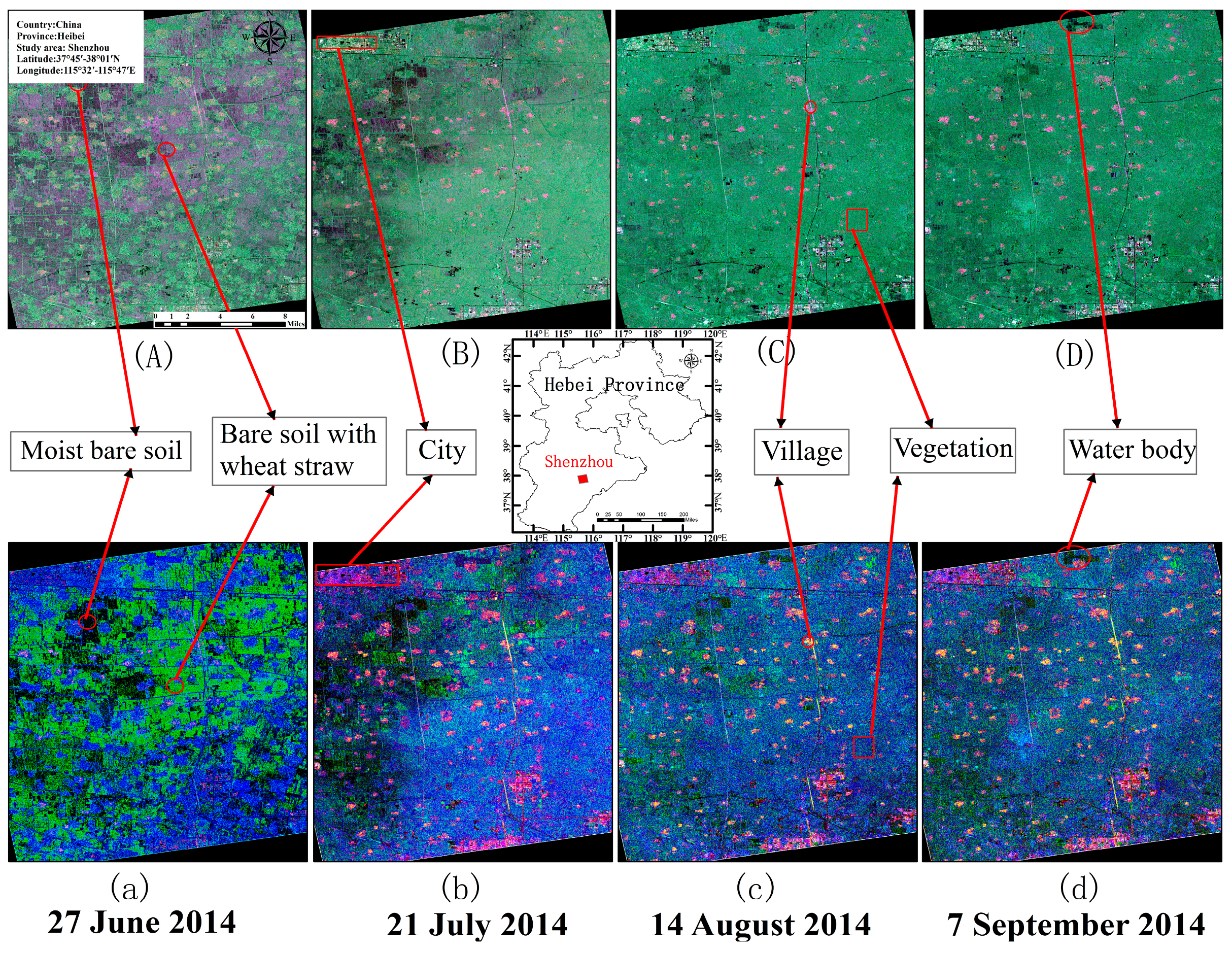

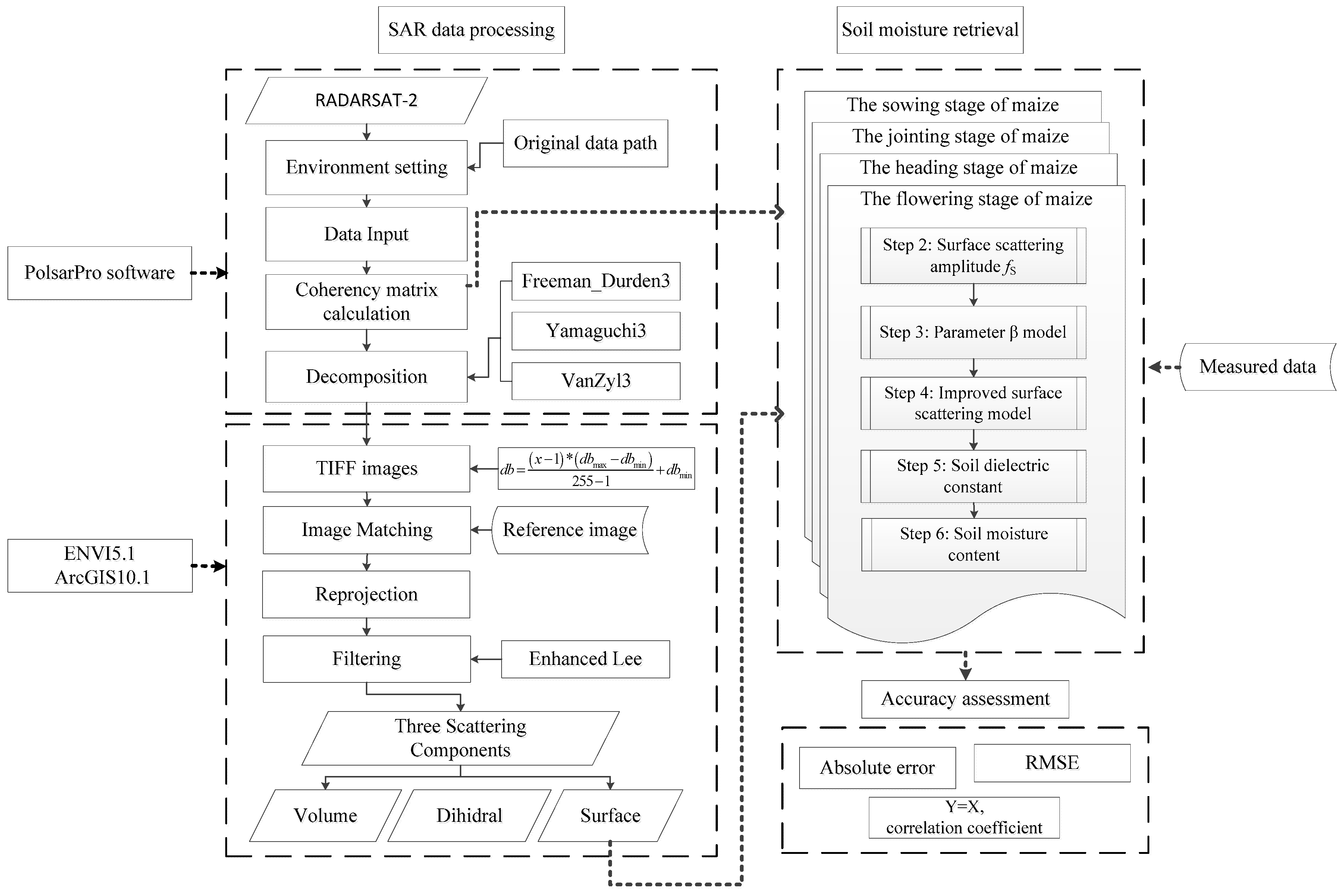
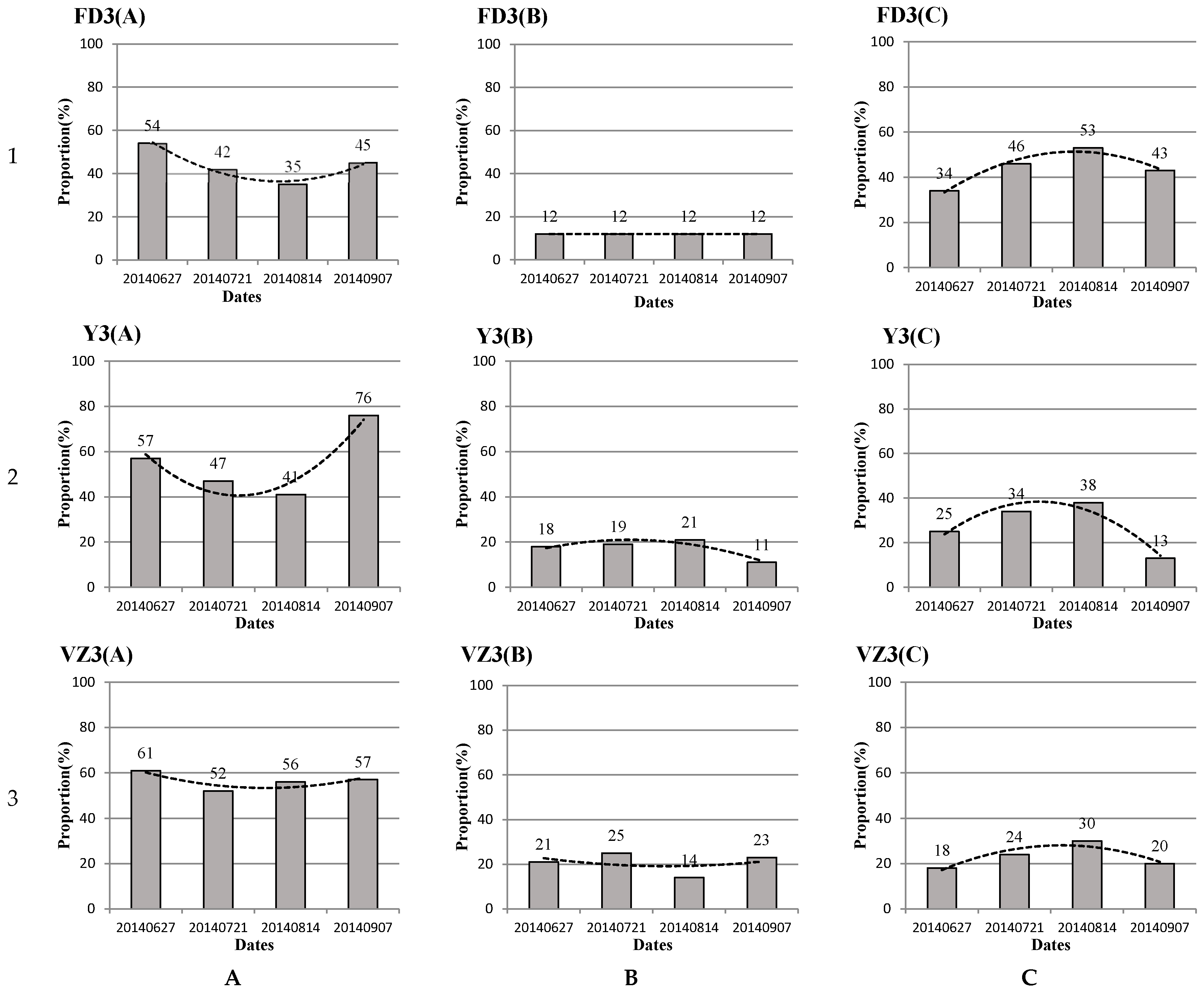
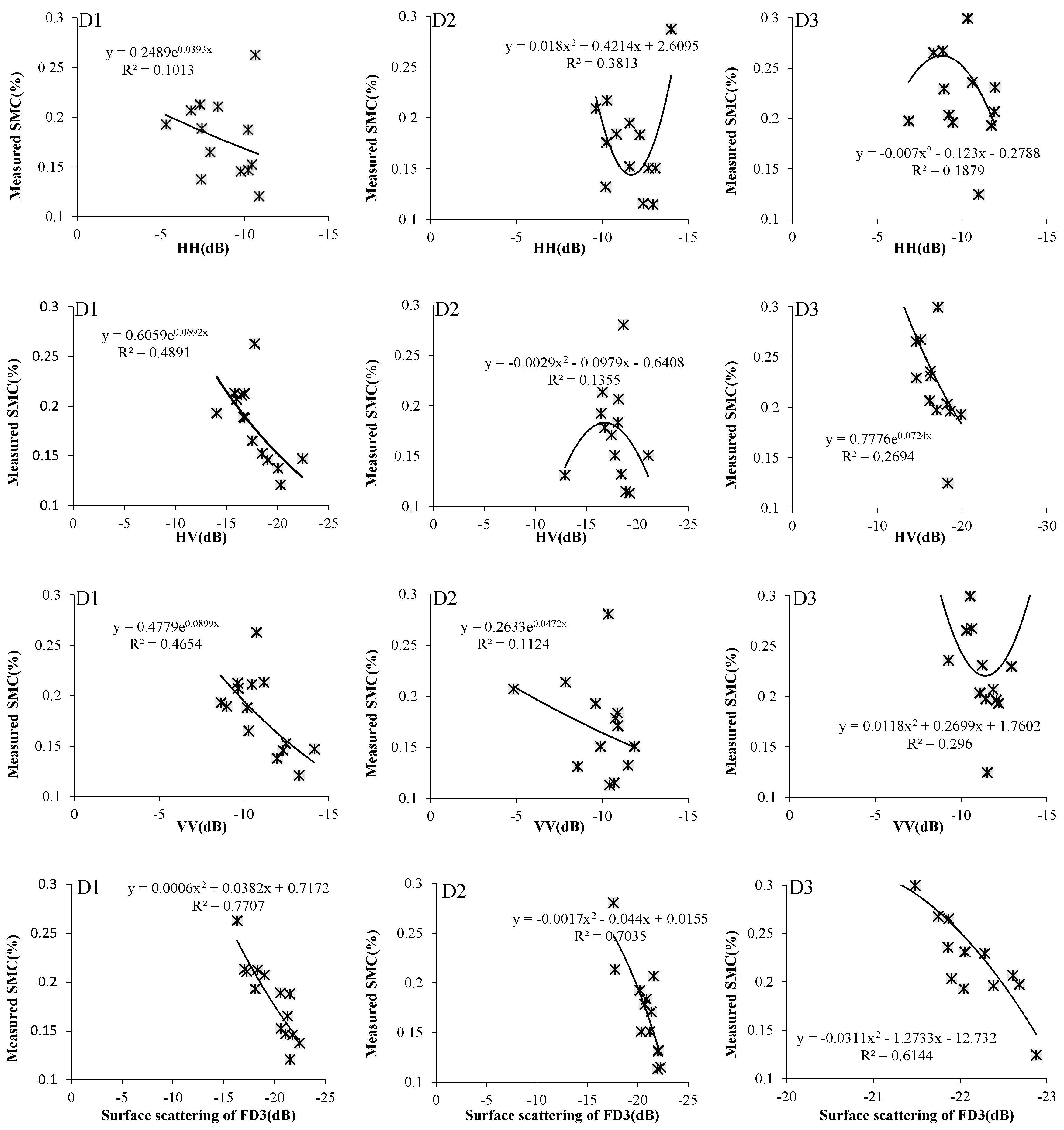
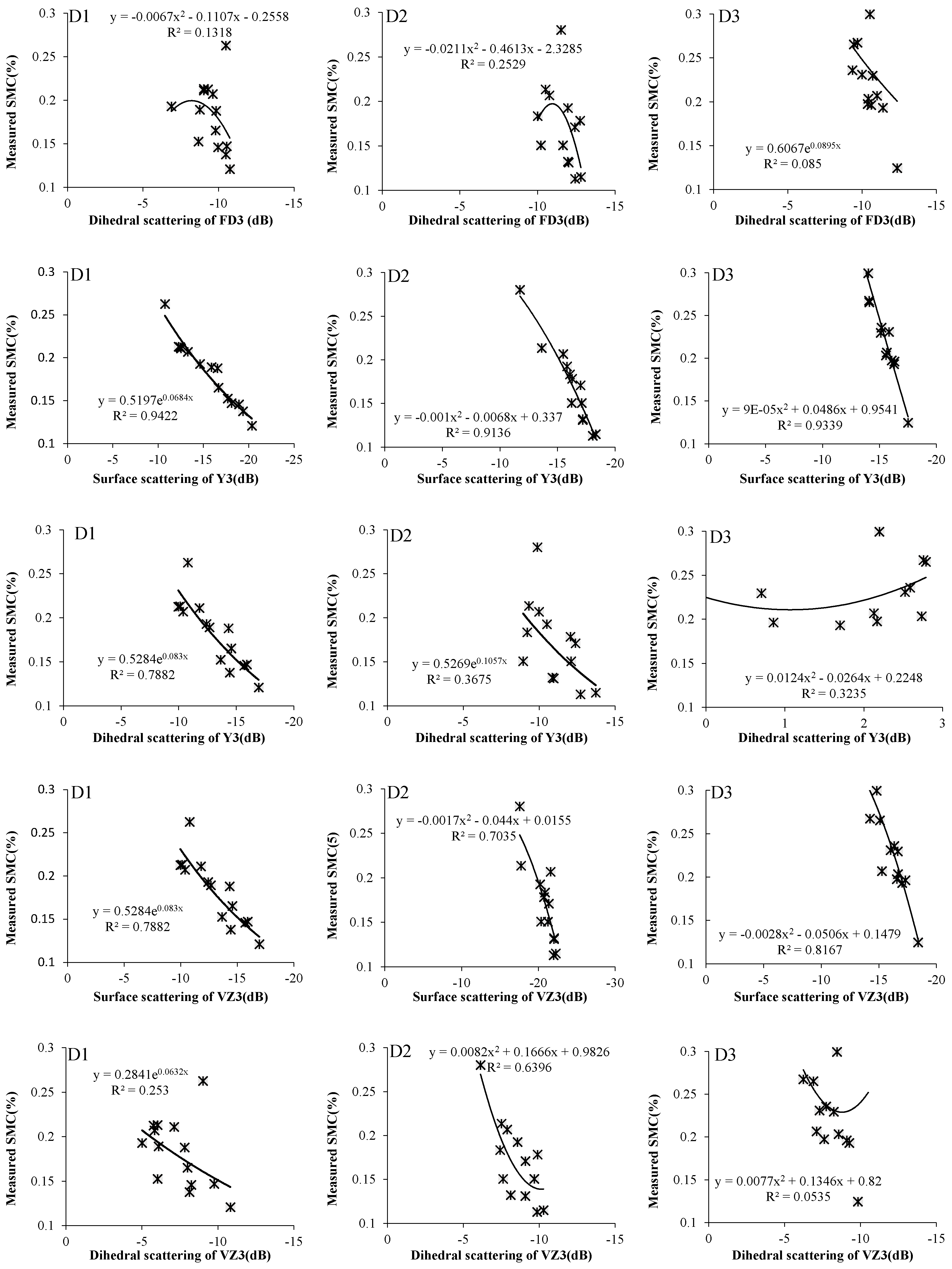
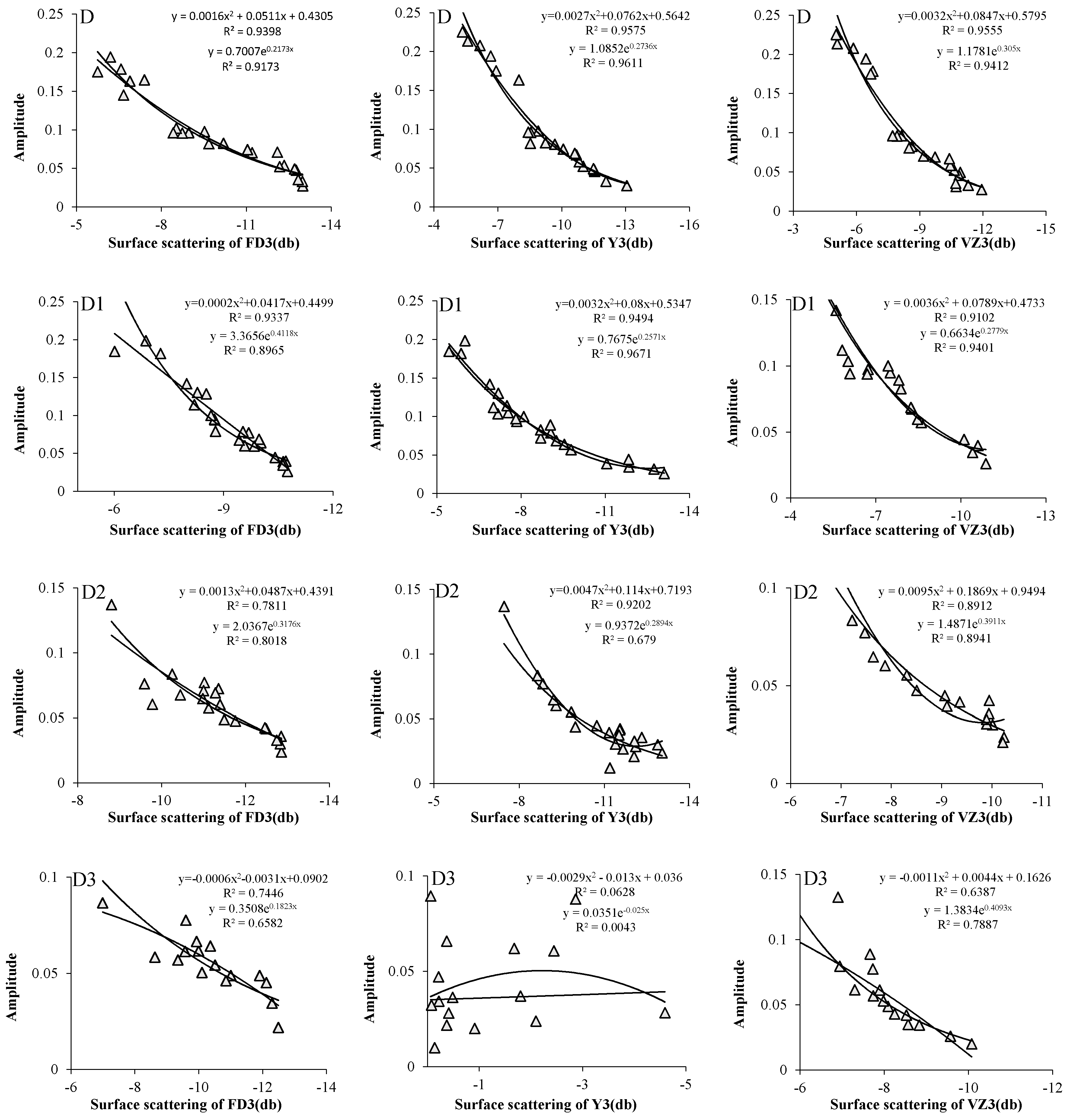
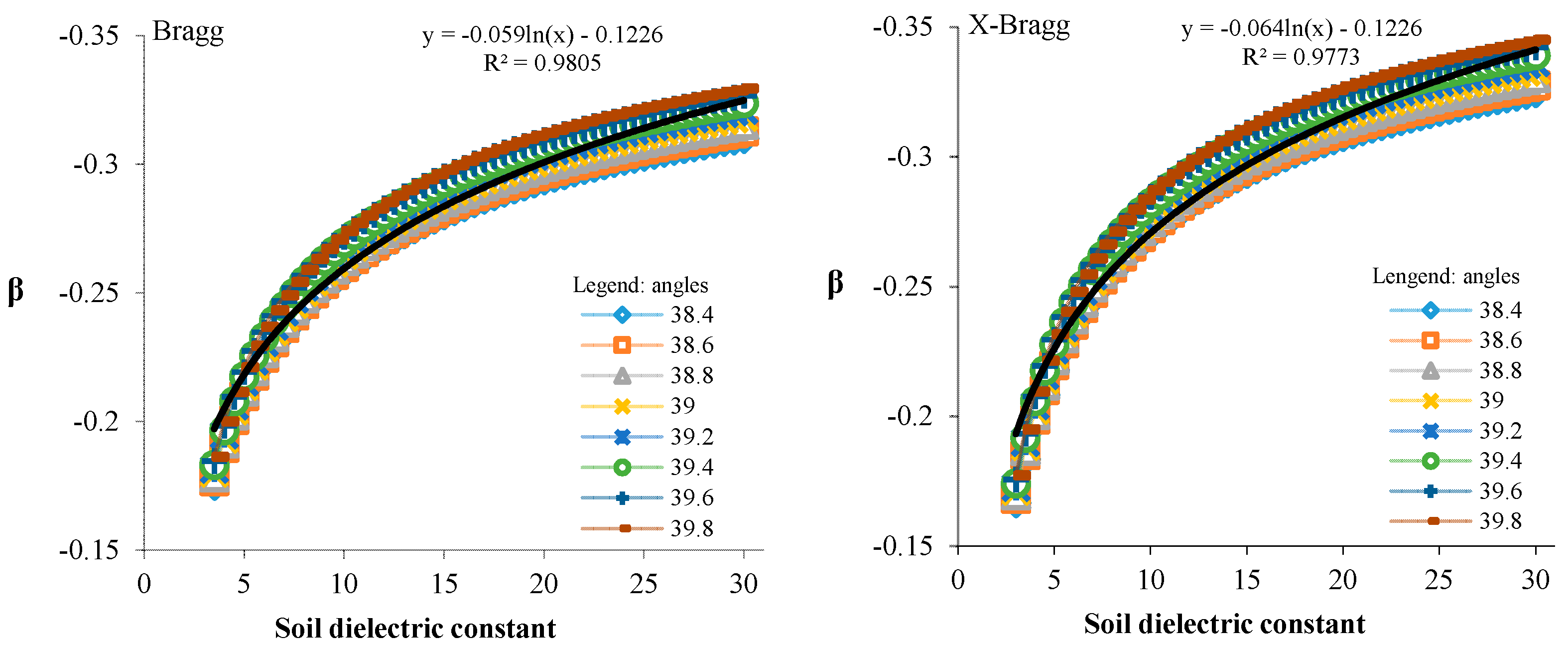
| Date | Time UTM | Scene Centre (Lat/Long) | Beam Model | Groundcover Type Number | Dominant Objects |
|---|---|---|---|---|---|
| 27 June 2014 | 10:17:30 | 37.9°N/115.6°E | Q19 | 6 | Bare soil/grasses/orchard |
| 21 July 2014 | 10:17:30 | 37.9°N/115.6°E | Q19 | 5 | Bare soil/maize area/orchard |
| 14 August 2014 | 10:17:30 | 37.9°N/115.6°E | Q19 | 4 | Maize area/orchard |
| 7 September 2014 | 10:17:30 | 37.9°N/115.6°E | Q19 | 4 | Maize area/orchard |
| Date | SN | SPN | SMC (g/cm3) | S (cm) | (g/cm3) | LAI | EWT (kg/m2) | H (m) | RD (cm) | RS (cm) | |
|---|---|---|---|---|---|---|---|---|---|---|---|
| 27 June 2014 | 23 | 64 | 5.62–48.1 | 0.4–3.4 | 2.3–0.1 | 1.578 | 0 | 0 | 0 | 0 | 0 |
| 12 July 2014 | 20 | 60 | 6.4–58.4 | 0.4–5.0 | 1.3–23.7 | 1.27 | 1.37 | 0.05–2.93 | 0.57 | 23.0 | 40.0 |
| 14 August 2014 | 20 | 60 | 9.1–40.9 | 0.2–3.0 | 3.7–25.0 | 1.33 | 2.89 | 0.48–5.13 | 2.19 | 22.7 | 41.5 |
| 7 September 2014 | 20 | 60 | 8.6–39.3 | 0.4–2.2 | 3.4–17.8 | 1.33 | 3.35 | 1.53–3.90 | 2.58 | 24.5 | 41.6 |
| Dates | Bragg | XBragg | I-Bragg | IX-Bragg | Improved SSM | N |
|---|---|---|---|---|---|---|
| 27 June 2014 | y = −0.059ln(x) − 0.1226 | y = −0.064ln(x) − 0.1226 | y = −0.059ln(Z) − 0.1226 | y = −0.064ln(Z) − 0.1226 | y = −0.0028x2 + 0.0242x − 0.5823 | 20 |
| 21 July 2014 | y = −0.059ln(x) − 0.1226 | y = −0.064ln(x) − 0.1226 | y = −0.059ln(Z) − 0.1226 | y = −0.064ln(Z) − 0.1226 | y = −0.0051x2 + 0.0238x − 0.4419 | 21 |
| 14 August 2014 | y = −0.059ln(x) − 0.1226 | y = −0.064ln(x) − 0.1226 | y = −0.059ln(Z) − 0.1226 | y = −0.064ln(Z) − 0.1226 | y = −0.0073x2 + 0.0970x − 0.8707 | 20 |
| 7 September 2014 | y = −0.059ln(x) − 0.1226 | y = −0.064ln(x) − 0.1226 | y = −0.059ln(Z) − 0.1226 | y = −0.064ln(Z) − 0.1226 | y = −0.0206x2 + 0.3393x − 1.8843 | 16 |
| Models | AEmax | RMSE | R2 | N |
|---|---|---|---|---|
| ISSM_D | 3.13 | 1.76 | 0.8843 | 12 |
| Bragg_D | 8.61 | 3.78 | 0.4700 | 12 |
| X-Bragg_D | 5.38 | 2.88 | 0.6865 | 12 |
| ISSM_D1 | 4.48 | 2.53 | 0.6874 | 17 |
| Bragg_D1 | 5.91 | 3.16 | 0.6309 | 17 |
| X-Bragg_D1 | 4.91 | 2.81 | 0.7288 | 17 |
| ISSM_D2 | 3.82 | 2.28 | 0.8181 | 14 |
| Bragg_D2 | 6.19 | 2.96 | 0.5945 | 14 |
| X-Bragg_D2 | 5.98 | 2.82 | 0.8314 | 14 |
| ISSM_D3 | 5.82 | 3.76 | 0.6599 | 17 |
| Bragg_D3 | 6.82 | 3.49 | 0.8301 | 17 |
| X-Bragg_D3 | 6.23 | 3.30 | 0.8098 | 17 |
© 2017 by the authors. Licensee MDPI, Basel, Switzerland. This article is an open access article distributed under the terms and conditions of the Creative Commons Attribution (CC BY) license ( http://creativecommons.org/licenses/by/4.0/).
Share and Cite
Xie, Q.; Meng, Q.; Zhang, L.; Wang, C.; Sun, Y.; Sun, Z. A Soil Moisture Retrieval Method Based on Typical Polarization Decomposition Techniques for a Maize Field from Full-Polarization Radarsat-2 Data. Remote Sens. 2017, 9, 168. https://doi.org/10.3390/rs9020168
Xie Q, Meng Q, Zhang L, Wang C, Sun Y, Sun Z. A Soil Moisture Retrieval Method Based on Typical Polarization Decomposition Techniques for a Maize Field from Full-Polarization Radarsat-2 Data. Remote Sensing. 2017; 9(2):168. https://doi.org/10.3390/rs9020168
Chicago/Turabian StyleXie, Qiuxia, Qingyan Meng, Linlin Zhang, Chunmei Wang, Yunxiao Sun, and Zhenhui Sun. 2017. "A Soil Moisture Retrieval Method Based on Typical Polarization Decomposition Techniques for a Maize Field from Full-Polarization Radarsat-2 Data" Remote Sensing 9, no. 2: 168. https://doi.org/10.3390/rs9020168






